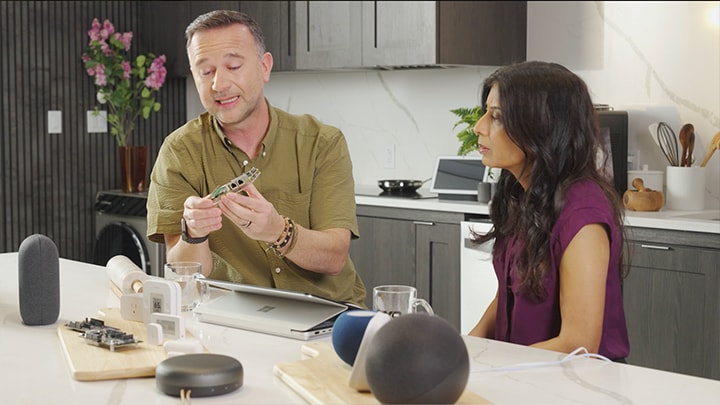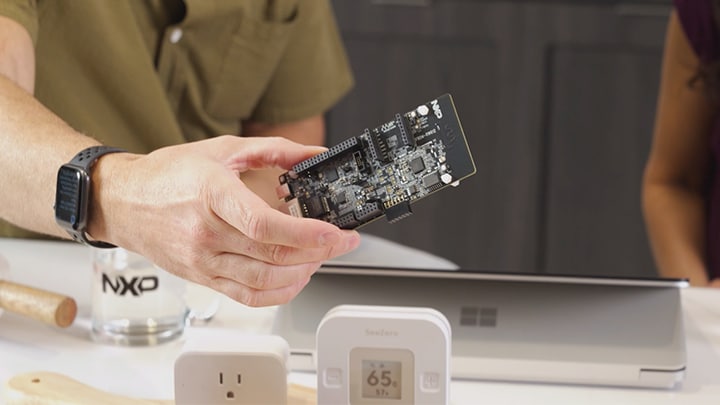Welcome you back to another episode recap from Conversations at the Edge (CATE)–our video series where we roll up our sleeves and chat through the evolving landscape of intelligent edge development.
Our first season, Making with Matter, is all about Matter’s place in the autonomous home.
If you are just tuning in, CATE is a monthly series Neal Kondel and I, Sujata Neidig, host from NXP’s Smart Home Innovation Lab to tackle the real questions product developers face when building intelligent, connected devices.
In Episode 1, we kicked things off by diving into the current state of Matter: the optimism, the growing pains and why 2025 feels like the year it all starts to click. We looked at Matter’s growing support from big ecosystems, the ongoing focus on multi-admin experiences and the promise of energy management as a killer app for intelligent automation.
The second Episode of "Conversations at the Edge," a monthly video series diving into the challenges and opportunities of building intelligent products.
The Real Work Begins
In Episode 2, we moved from philosophy to execution. We are calling this one Baking with Matter and not just because we like a good kitchen metaphor, but because of the preparation involved in Matter product development. This episode focuses on the four essential steps to bringing a Matter device to market: defining your requirements, developing on the right platform, navigating certification and planning deployment.
Neil and I discussed how the journey does not start with picking a connectivity protocol. It starts with defining the use case. What is the product trying to do? Where does it live in the smart home? What level of processing, user interface and power consumption does it require? Only then can you make the right decisions around connectivity (Wi-Fi, Thread, both?), architecture and security.
And speaking of security, it is no longer optional or an afterthought. From secure elements to hardware-based enclaves, we discussed how Matter’s certificate-based model demands real investment in device protection. But, more than just meeting Matter’s baseline, it is about understanding the risk profile of your specific application and designing it accordingly.
 Sujata and Neil discuss the four essential steps to bringing a Matter device to market.
Sujata and Neil discuss the four essential steps to bringing a Matter device to market.
NXP's new video series explores the challenges and opportunities that come with building intelligent products at the edge of innovation. Be sure to watch Episode One.
Prototyping Platforms and Real-World Tools
One of the themes we circled back to again and again was speed. Developers need to get to proof-of-concept fast and that means having access to the right tools. We showcased NXP’s portfolio of FRDM development boards, like the tri-radio RW612 and the MCX W71 and how those pair with software development kids (SKDs) and the Application Code Hub (ACH) for rapid prototyping. It does not matter if you are building a minimal sensor or a full-featured thermostat; these kits and software tools help translate use cases into code and hardware quickly.
And it does not stop at prototyping. With Zephyr and FreeRTOS support, Linux BSPs and regular SDK updates that integrate the latest Matter releases, we want to make sure that what developers build on day one scales all the way to production.
 NXP’s FRDM platforms offers low-cost, modular hardware and software and tools to design Matter products.
NXP’s FRDM platforms offers low-cost, modular hardware and software and tools to design Matter products.
Cracking the Certification Puzzle
Let us be honest. Certification is often the most-opaque part of the launch process. Matter complicates this further by layering app-level certification on top of existing transport protocols like Wi-Fi, Thread and Bluetooth. Our conversation explored the burden this places on developers and how platforms like ours are stepping in to lighten the load.
By certifying our chips for Thread, for example, NXP allows developers to inherit that certification for their own devices and bypass the need for redundant testing. We are also working with the Connectivity Standards Alliance to bring similar inheritance programs to Matter certification.
And let us not forget why this matters (pun intended). Certification is what guarantees that a Matter-enabled device can truly interoperate with other devices in the ecosystem. That is the heart of Matter’s promise and it is only as strong as the certification process behind it.
Deployment, Trust and the Blockchain Ledger
Once your product is built and certified, it is still not ready to ship. The deployment phase involves provisioning each device with a Device Attestation Certificate (DAC) and onboarding it to the Matter blockchain ledger. This is what allows devices to join Matter fabrics securely and be recognized as trusted components in a multi-vendor home.
We talked about NXP’s involvement as a Product Attestation Authority (PAA) and how our EdgeLock® 2GO service helps customers inject these credentials during manufacturing, at remote factories, or even in the field. This step is a must-have for smaller manufacturers and startups who may not have their own security infrastructure.
Get Involved or Get Left Behind
To wrap things up, we spent some time reflecting on why participation in the Matter community matters so much. Neil and I both sit on the CSA and Thread Group boards and we have seen firsthand how developer voices are shaping the standard. From defining new device types to proposing new onboarding flows, there’s room for companies of every size to contribute.
Beyond influencing the spec, joining the community is also a great chance for networking, discovering new opportunities and understanding where the industry is headed next. If you are building Matter devices and not engaging with CSA or Thread Group, you are missing a big piece of the puzzle.
What Is Next: Energy As the Killer Use Case?
Episode 3 is where things really heat up. We will be diving into Matter’s role in energy management and how smart home devices are evolving from convenience tools into components of a more intelligent, efficient home infrastructure.
So, if you have not already, watch both Episode 1 and Episode 2, let us know what you are cooking up and how we can help with your next course in our Matter meal prep.
See you next month for our season finale!



